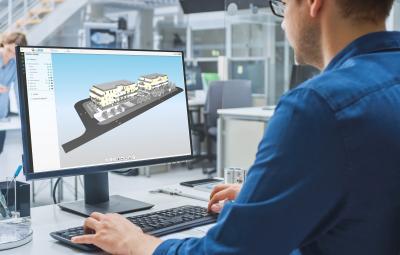BIMming is winning
Details of BIMming is winning
- Date 28/09/2021
- Software
- Categories
Everyone in the AEC industry is familiar with the acronym BIM nowadays. Whether you work in a BIM process workflow or not, there’s no way to ignore it. A temporary trend or a logical next step in an ever-changing digital world? Let’s dig a little deeper and find out.

While a misconception exists that BIM is ‘just’ about 3D modelling, it is important to note that BIM is a way of working. ISO 19650:2019 defines BIM as follows: "the use of a shared digital representation of a built asset to facilitate design, construction and operation processes to form a reliable basis for decisions". Whoever has worked on a building project knows for sure: the bigger the project, the more collaboration and the more communication is required. And collaboration and communication are the cornerstones of BIM.
By bringing together in one place all information about every part of a building, BIM allows anyone to access that information at any given moment. This leads to an output known as a Building Information Model. Updates of such a model can happen continuously and in a way that everyone in the project stays updated. Because the project is already built virtually, the physical construction of the building is better prepared and possible challenges can be overcome in an earlier stage, leading to higher efficiency and less risks on site.
As already briefly mentioned, working with a BIM process workflow implies many practical advantages for everyone involved. The collaboration and communication between stakeholders, from architects and modellers to structural engineers and draughtsmen, improves significantly. Everyone works on an up-to-date model which naturally leads to less errors, less rework and increased efficiency. Because of the accuracy of the detailed model, better estimations can be made, leading to better cost optimization and to less waste from a material perspective too. The project as a whole benefits from BIM since an improvement in build quality can be noticed.

Despite its change-averse nature, the industry has definitely changed. A study conducted by NBS revealed that the growth in the awareness and use of BIM is indisputable: in ten years’ time, the adoption rate increased with almost 60%. The study on BIM adoption in Europe done by PlanRadar reviewed the level of support governments have given to BIM technology and digital working practices. Obviously, the countries most advanced in terms of using BIM are the ones in which the level of government intervention and investment in BIM are the highest. In the UK, for instance, achieving a certain BIM level became a mandatory part of procurement for government projects as from 2016.
There is, however, the other side of the coin: only 40% say that BIM is the norm for project information. Even though the benefits are clear, some key arguments pop up regularly as barriers to adoption. Clients play a key role in encouraging the use of BIM in projects. Moreover, many professionals state that BIM is not appropriate for small projects. For BIM to be truly universal, and to be business as usual across the industry, these issues need to be addressed.
At SCIA, a brand of the Nemetschek group, we really believe in the success of the collaboration between all disciplines. It is at the heart of delivering a safe, sustainable built environment, which in turn leaves a positive lasting legacy. That’s why we are constantly looking for ways to improve the engineering workflow and to make BIM a workable reality for all by addressing the challenges different stakeholders face. From our angle and experience with sister brands in the Nemetschek group, the goal is to reduce the time it takes to create analysis models, to ensure structural models and analysis models show the same reality at every step in the project and to make the management of changes between disciplines seamless. As an Open BIM frontrunner, SCIA was awarded by buildingSMART International as the first company to pass the certification of the interoperability standard IFC 2x3 for structural model exchange with SCIA Engineer. As the need for efficiency in construction keeps increasing, so does the maturity of the solutions offered.

, and what’s more, it gives the engineer full control over the process. The solution maximises data reuse and minimises manual handling across the entire process – eliminating the need for time-consuming, bothersome remodelling tasks, 150 times faster than standard processes.
While AutoConverter focuses on buildings and infrastructure projects by optimising the existing federated model workflow where different stakeholders use distinct separate models, there’s another solution currently available that focuses on buildings with the shared model workflow as a collaborative environment between architects (using Archicad) and engineers (using SCIA Engineer): Integrated Design solution. This collaborative software, which is a collaboration between Graphisoft and SCIA, allows every team member to have access to the latest information and, based on authorization parameters, to share comments and suggestions and modify the model. Every change is tracked so every team member can understand the genesis path of the project. Furthermore, it is the only solution allowing architects and engineers to work on one single model in comparison to a federated model workflow.
What the future of construction will look like is hard to predict – we’re software developers, not fortune tellers! One thing we’re certain of: BIM is here to stay. Different factors – legal, environmental and economic – will make sure in due time the whole industry will work in a BIM workflow. For now, we at SCIA would like to contribute where we can. SCIA AutoConverter and Graphsoft’s Integrated Design can already bring us one step closer to a BIM future for all.
Source: 10th annual BIM report – 2020, NBS, https://www.thenbs.com/knowledge/national-bim-report-2020